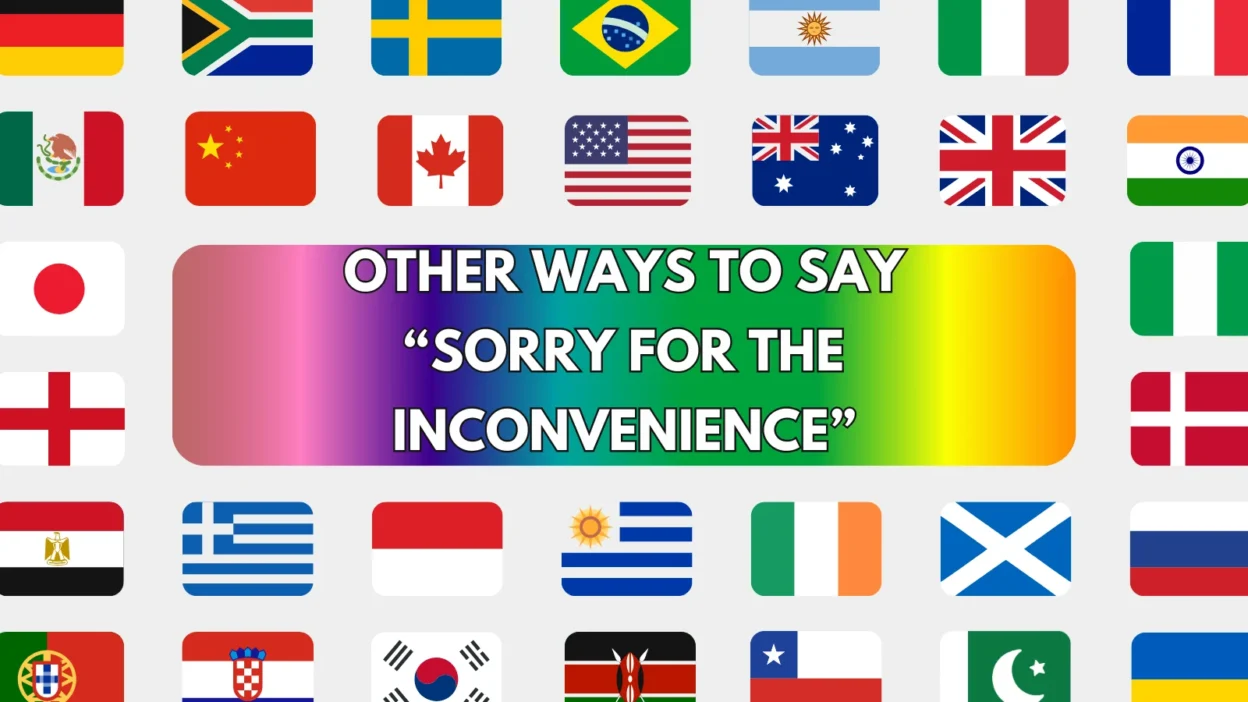“Sorry for the inconvenience” is a commonly used phrase to apologize for causing discomfort, disruption, or delay. While it is polite and widely accepted, it can sometimes feel generic or overused — especially in professional settings or customer communication. To sound more genuine, empathetic, or even professional, having alternative ways to express this sentiment is very useful.
Below are 25 alternative expressions for “Sorry for the inconvenience,” each with explanation and guidance to help you respond with more care and clarity in different situations.
1. I apologize for the trouble
Meaning:
A direct apology for causing a problem or disruption.
Detailed Explanation:
This is a straightforward and sincere way to acknowledge an issue while showing regret.
Scenario Example:
I apologize for the trouble caused by the delayed delivery.
Best Use:
Emails, customer service replies, business communication.
Tone:
Polite, professional.
2. Thank you for your patience
Meaning:
Acknowledges someone’s tolerance while subtly apologizing.
Detailed Explanation:
This shifts the focus from the problem to the person’s grace in handling it, making it feel more positive.
Scenario Example:
Thank you for your patience while we resolve this technical issue.
Best Use:
Customer support, client relations.
Tone:
Appreciative, professional.
3. We regret the inconvenience
Meaning:
Expresses formal remorse for a disruption or error.
Detailed Explanation:
Often used in corporate or official communication; it shows accountability.
Scenario Example:
We regret the inconvenience caused by our system outage earlier today.
Best Use:
Formal announcements, company apologies.
Tone:
Official, respectful.
4. Apologies for the delay
Meaning:
Specifically apologizes for being late or slow.
Detailed Explanation:
Useful when time is the issue — simple and focused.
Scenario Example:
Apologies for the delay in getting back to you.
Best Use:
Emails, customer communication.
Tone:
Polite, to the point.
5. I’m truly sorry for the disruption
Meaning:
A more heartfelt and empathetic apology.
Detailed Explanation:
This phrase works well when the inconvenience had a real impact on someone.
Scenario Example:
I’m truly sorry for the disruption this has caused to your schedule.
Best Use:
One-on-one messages, personal outreach.
Tone:
Empathetic, sincere.
6. I understand how frustrating this must be
Meaning:
Shows empathy while acknowledging the situation.
Detailed Explanation:
More than just an apology, this expression connects emotionally with the person affected.
Scenario Example:
I understand how frustrating this must be, and I assure you we’re working on a solution.
Best Use:
Customer service, sensitive responses.
Tone:
Compassionate, human.
7. Sorry for the trouble
Meaning:
A casual yet thoughtful way to apologize.
Detailed Explanation:
Less formal than “inconvenience,” and often feels more genuine.
Scenario Example:
Sorry for the trouble — I’ll get this fixed right away.
Best Use:
Everyday conversations, informal messages.
Tone:
Casual, caring.
8. Please accept my apologies
Meaning:
A formal and respectful way to offer an apology.
Detailed Explanation:
It sounds courteous and is often used in professional writing.
Scenario Example:
Please accept my apologies for the confusion caused.
Best Use:
Emails, client communication, formal writing.
Tone:
Polished, respectful.
9. Thank you for bearing with us
Meaning:
Acknowledges someone’s patience during an issue.
Detailed Explanation:
This phrase feels friendly and optimistic, even during disruptions.
Scenario Example:
Thank you for bearing with us while we upgrade our system.
Best Use:
Service interruptions, updates.
Tone:
Grateful, calm.
10. Sorry for any confusion caused
Meaning:
Apologizes specifically for misunderstandings.
Detailed Explanation:
This shows that you recognize the issue and want to clear things up.
Scenario Example:
Sorry for any confusion caused by the new schedule.
Best Use:
Clarifications, changes in plans.
Tone:
Clear, responsible.
11. We appreciate your understanding
Meaning:
Expresses gratitude while gently acknowledging the problem.
Detailed Explanation:
It’s polite, forward-looking, and works as a soft apology.
Scenario Example:
We appreciate your understanding as we address this issue.
Best Use:
Service messages, professional communication.
Tone:
Respectful, appreciative.
12. I’m sorry for the oversight
Meaning:
Apologizes for a specific error or missed detail.
Detailed Explanation:
This phrase is good when you or your team made a mistake unintentionally.
Scenario Example:
I’m sorry for the oversight — we’ll correct the invoice right away.
Best Use:
Business, customer service.
Tone:
Humble, responsible.
13. My apologies for the inconvenience caused
Meaning:
A slightly formal variation of the original phrase.
Detailed Explanation:
This version feels more human while still maintaining formality.
Scenario Example:
My apologies for the inconvenience caused by the billing error.
Best Use:
Professional emails, public notices.
Tone:
Formal, courteous.
14. Sorry for the mix-up
Meaning:
Acknowledges a small or accidental mistake.
Detailed Explanation:
Casual and conversational, good for minor slip-ups.
Scenario Example:
Sorry for the mix-up — I sent the wrong attachment earlier.
Best Use:
Informal messages, coworker communication.
Tone:
Friendly, easygoing.
15. I realize this caused disruption
Meaning:
Acknowledges the impact of a mistake or delay.
Detailed Explanation:
Shows self-awareness and takes responsibility.
Scenario Example:
I realize this caused disruption to your schedule, and I sincerely apologize.
Best Use:
Serious mistakes, formal apologies.
Tone:
Honest, accountable.
16. I know this was inconvenient
Meaning:
Recognizes and validates the person’s discomfort.
Detailed Explanation:
This statement offers empathy and connection.
Scenario Example:
I know this was inconvenient for you, and I truly regret the mistake.
Best Use:
Direct conversations, customer support.
Tone:
Empathetic, understanding.
17. We’re sorry for the experience
Meaning:
Acknowledges a general problem or disappointment.
Detailed Explanation:
Useful when the issue is broad or customer-related.
Scenario Example:
We’re sorry for the experience you had with our support team.
Best Use:
Customer feedback, company apologies.
Tone:
Professional, caring.
18. Sorry about that
Meaning:
Very casual and common way to apologize.
Detailed Explanation:
Best used in informal or internal communications.
Scenario Example:
Oops — forgot to reply earlier. Sorry about that!
Best Use:
Texts, chats, informal emails.
Tone:
Light, casual.
19. I take full responsibility
Meaning:
Expresses accountability directly and clearly.
Detailed Explanation:
Strong and mature — shows ownership of the situation.
Scenario Example:
I take full responsibility for the delay in this report.
Best Use:
Professional communication, leadership roles.
Tone:
Accountable, honest.
20. Please forgive the mistake
Meaning:
Asks for forgiveness in a humble tone.
Detailed Explanation:
This phrase is personal and best used when the impact was significant.
Scenario Example:
Please forgive the mistake — it wasn’t our intention to cause confusion.
Best Use:
Direct messages, sincere apologies.
Tone:
Humble, heartfelt.
21. I’m sorry things didn’t go smoothly
Meaning:
Acknowledges that the process or experience was difficult.
Detailed Explanation:
Useful for customer service or team updates when expectations weren’t met.
Scenario Example:
I’m sorry things didn’t go smoothly during your check-in process.
Best Use:
Support responses, hospitality.
Tone:
Genuine, sympathetic.
22. We’ll do better next time
Meaning:
A promise of improvement following an error.
Detailed Explanation:
This phrase shows action and future commitment, which reassures the receiver.
Scenario Example:
We know we missed the mark this time, and we’ll do better next time.
Best Use:
Team talks, customer follow-up.
Tone:
Hopeful, accountable.
23. Sorry for the setback
Meaning:
Acknowledges a delay or hindrance.
Detailed Explanation:
Suitable for projects or team delays.
Scenario Example:
Sorry for the setback — we’ve adjusted our timeline accordingly.
Best Use:
Project management, internal communication.
Tone:
Calm, responsible.
24. I appreciate your flexibility
Meaning:
Thanks someone while subtly recognizing a disruption.
Detailed Explanation:
It’s positive, with a focus on the recipient’s cooperation.
Scenario Example:
I appreciate your flexibility with the meeting changes.
Best Use:
Professional, team settings.
Tone:
Gracious, respectful.
25. Sorry for the interruption
Meaning:
Apologizes for breaking focus or concentration.
Detailed Explanation:
Simple but specific to situations where you’ve disturbed someone.
Scenario Example:
Sorry for the interruption — do you have a minute?
Best Use:
Meetings, workplace communication.
Tone:
Polite, efficient.
Conclusion
“Sorry for the inconvenience” is a classic phrase, but using thoughtful alternatives can add genuineness, professionalism, and empathy to your message. Whether you’re talking to a customer, teammate, or friend, the right phrase can ease frustration and build stronger communication. These 25 alternatives help you say sorry — but better.




